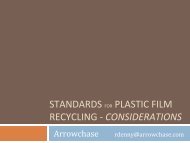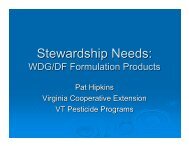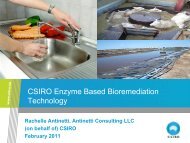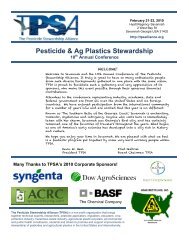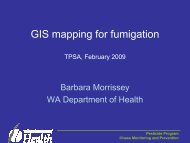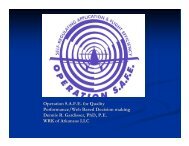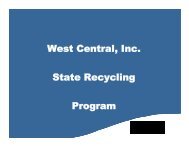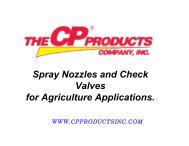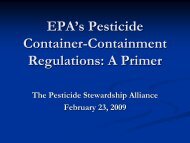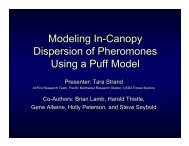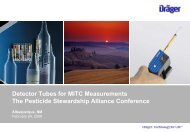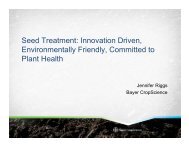Clean Sweep Programs - US Environmental Protection Agency
Clean Sweep Programs - US Environmental Protection Agency
Clean Sweep Programs - US Environmental Protection Agency
- No tags were found...
You also want an ePaper? Increase the reach of your titles
YUMPU automatically turns print PDFs into web optimized ePapers that Google loves.
The <strong>Clean</strong> <strong>Sweep</strong> Reportshort-term or longer-term, activities for internationalcoordination, place-based remediation of existingPBT contamination, research, technology developmentand monitoring, community and sector-basedprojects, and outreach including public advisories.In EPA’s draft PBT National Action Planfor Level 1 Pesticides, 3 one of the goals forreducing risks from the Level 1 pesticides is to“facilitate, encourage, and support states, tribes andlocal governments in their programs to collect andproperly dispose of unwanted pesticides, includingstocks of Level 1 pesticides.” The draft planacknowledges the important role <strong>Clean</strong> <strong>Sweep</strong>programs play in safely removing pesticides –specifically the Level 1 pesticides – from theenvironment. In fact, this report on <strong>Clean</strong> <strong>Sweep</strong>programs is partially financed by funds from the PBTinitiative.Some <strong>Clean</strong> <strong>Sweep</strong> programs recordinformation about the specific pesticides collected.This information currently provides the only recordof the volume of PBT pesticides collected and theonly basis for estimating amounts uncollected.Minnesota, for example, has comprehensive data onamounts of specific pesticides collected. From thelate 1980’s through 1998, about 6 percent of thepesticides collected in Minnesota were the PBTLevel 1 pesticides. The voluntary efforts by stateagencies to itemize the pesticides collected haveprovided very useful data and EPA has urged thatthese efforts continue.Persistent Organic PollutantsOn May 23, 2001, the U.S. signed theConvention on Persistent Organic Pollutants(POPs) 4 in Stockholm, Sweden. Under theConvention, countries commit to reduce and/oreliminate the production, use, and/or release of thetwelve POPs of greatest concern to the globalcommunity (see box) and to establish a mechanismby which additional chemicals may be added to theConvention in the future. The U.S. stronglysupported efforts to complete this agreement, whichwill have wide-ranging environmental and healthbenefits. The pesticides included in the StockholmConvention are commonly collected and disposedduring <strong>Clean</strong> <strong>Sweep</strong> programs.Persistent Organic Pollutants in theConventionPesticidesaldrinchlordaneDDTdieldrinendrinheptachlorhexachlorobenzenemirextoxapheneNon-pesticidesPCBsPCDD (dioxins)PCDF (furans)StockholmSolid and Hazardous Waste ManagementEPA regulates solid and hazardous wastesunder the Resource Conservation and Recovery Act(RCRA). RCRA’s goals are to protect people fromthe hazards of waste disposal; conserve energy and3Draft PBT National Action Plan for the Level 1 Pesticides, Public Review Draft, prepared by the <strong>US</strong> EPA Persistent,Bioaccumulative and Toxic Pollutants (PBT) Pesticides Work Group, August 24, 2000. An announcement about its availability and arequest for comments was published in the Federal Register on November 1, 2000 (65 FR 65314).4United Nations Environment Program for POPs: http://irptc.unep.ch/pops3



